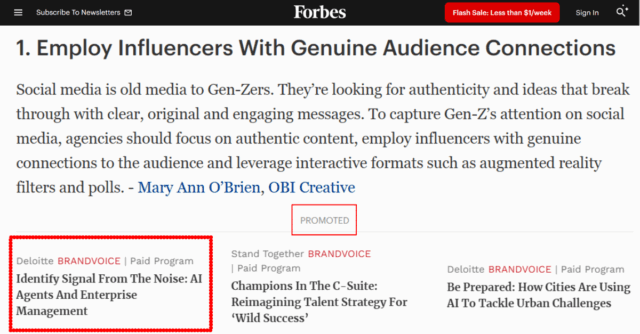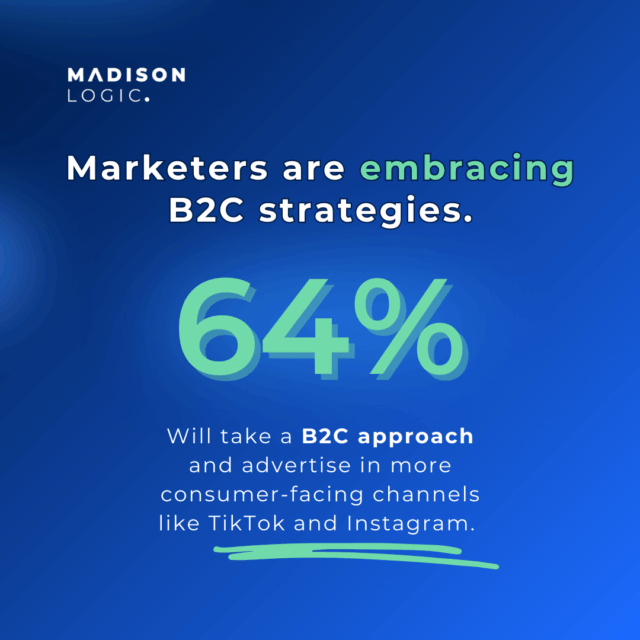
Unlock Global ABM at Scale — Madison Logic strengthens ABM reach with Connected TV and Audio expansion globally. Learn More
Unlock Global ABM at Scale — Madison Logic strengthens ABM reach with Connected TV and Audio expansion globally. Learn More

Digital advertising is evolving fast. With the changes in third-party cookies and rising data privacy regulations (GDPR, CCPA, CASL, and SOC 2 Type II, for example), marketers are being forced to rethink how they reach and resonate with their audiences. Native advertising, when done right, fits naturally into this new era, where marketers face mounting pressure to prioritize user consent, data minimization, and ethical data practices.
The beauty of native advertising is that it doesn’t rely on invasive tracking. Instead, it aligns marketing content with context—offering helpful, relevant material in environments where users are already engaging. That makes it inherently respectful of the user experience, and a natural fit for the privacy-first future.
But that doesn’t mean you’re operating in the dark. Intent data gives you visibility into what buyers care about without violating trust. By combining intent data with contextual signals and first-party engagement data, you can craft native content that meets prospects where they are, without crossing lines they’ve clearly drawn.
Privacy-first doesn’t mean performance-last. It means smarter targeting, stronger content, and more sustainable relationships. And mastering these 10 native advertising best practices is the key to staying relevant, effective, and ahead of the curve.
Authenticity and transparency aren’t nice-to-haves—they’re necessities. B2B buyers, especially millennials and Gen Z, are more discerning than ever. Seventy-three percent of Gen Z make buying decisions based on their values, and only 53% perceive brands as authentic. They’ve grown up in an environment saturated with advertising and are quick to spot anything that feels forced, disingenuous, or manipulative. Native advertising must be built on a foundation of honesty to earn their attention and trust.
Start with transparency at the surface level. Native ads should always be clearly labeled as sponsored content.
Trying to “blend in” without disclosing intent could be labeled as misleading. Clear labels set expectations, create credibility, and signal that your brand respects the audience’s intelligence. Beyond transparency in labeling, your native content must provide a real value-add. Whether it’s thought leadership, a practical how-to, or a data-driven insight, every piece of content should serve the buyer first. Buyers are more likely to engage with content that informs, solves, or inspires.
As AI-generated content becomes more widespread, trust becomes even more fragile. Readers are beginning to question not just what content says, but who (or what) created it. To combat this in your native advertising, lean into human-first storytelling that reflects real expertise, experience, and empathy. In a world where content can be created in seconds, what stands out is authenticity.
Transparency should also extend to your partnership practices. If you’re working with third-party platforms or publishers to deliver native content, be selective. By choosing partners who prioritize transparent practices, you can verify data integrity, make informed strategic decisions, optimize your marketing plans, and drive superior results.
In native advertising, your headline and description are make-or-break moments. These are often the only elements a B2B buyer sees before deciding whether to engage. That means they need to be precise, persuasive, and purposeful.
But native ad copy has to do more than just attract attention. Native advertisements exist to serve a marketing objective. Every headline and description must strike a delicate balance: resonating with an individual reader, in a specific vertical, at a particular moment in their journey.
This is where smarter, quality data strategies come into play. By leveraging ABM tools and sources like intent data, firmographics, technographics, CRM insights, and marketing automation platform (MAP) engagement signals, marketers can move beyond generic messaging to create highly targeted, timely native ads that align with what buyers are actively researching and how they’re interacting with your brand. Rather than pushing out the same headline to everyone, these data points allow you to tailor messages to, for example, a cybersecurity lead in a healthcare organization who just attended a webinar, or a procurement executive in manufacturing who’s visited your pricing page twice in the last week. It’s not about casting a wider net, it’s about precision at scale.
Here are a few tips on how to craft compelling headlines and descriptions:
Native advertising lives at the intersection of your brand’s identity and a publisher’s editorial environment. Striking a careful balance between maintaining your brand’s unique voice and respecting the format, tone, and standards of the platform where the ad appears.
Respecting both brand and editorial guidelines ensures that your content contributes value to the reading environment instead of standing out as a hard sell. When native content aligns well with brand awareness and editorial context, it becomes a meaningful piece of content that earns engagement and builds credibility.
Consistency is key. Whether your brand voice is authoritative, playful, or deeply technical, your native content should reflect that. A mismatch in tone can be confusing, especially for B2B buyers who may previously be familiar with your brand.
Establish voice and tone guidelines that apply across all content formats, including native. This ensures that your messaging stays cohesive, whether it’s a white paper, social post, or a sponsored article. Even within the more casual style of native placements, your brand’s personality should shine through.

Native ads should feel at home on the platform where they appear. You need to follow each publisher’s tone, formatting, and content guidelines from headline length and language to image size and layout. Study high-performing content on the platform to understand what works. Then, adapt your creative to fit the environment without losing your brand’s voice. The goal is to blend in naturally while standing out with value.
Pay attention to:
Audiences and buying groups don’t consume content in just one way, so why advertise in just one format? Great native strategy adapts to attention spans, device types, and user habits by serving the right format at the right time. By experimenting with multiple native ad formats, you can meet your audience where they are and how they prefer to engage, whether they’re scrolling through a feed, reading editorial content, or watching videos during a lunch break.
Each native ad placement and format offers unique strengths, depending on your goals:
Don’t be afraid to try new formats and combinations—what works best may surprise you. Continuous experimentation and A/B testing is key to unlocking native advertising’s full potential.
Even the best content marketing falls flat if it reaches the wrong audience, or the right one at the wrong time. Traditional audience targeting—based on job titles or firmographics alone—no longer cuts it. In a competitive B2B landscape, data is the variable that separates meaningful engagement from wasted impressions. To create native ads that convert, marketers must go beyond basic targeting and job titles and focus on what truly matters: data.
Modern marketers have a wealth of data at their fingertips, but it’s the smart combination of these datasets that drives results. Effective native ad targeting often blends:
Together, these sources empower marketers to go far beyond demographic guesses and deliver more personalized buyer experiences at the moment it matters most.
Intent data helps marketers move beyond who the buyer is to what they’re actively researching. Are they comparing vendors? Exploring trends? Looking for implementation tips? When native ads align with these signals, they become timely, relevant, and personalized touchpoints.
Native advertising shines when you map B2B buyer personalization to where a prospect is in the buyer’s journey:
Most B2B decisions aren’t made by one person. According to Gartner, a typical buying committee for a complex B2B solution consists of 14-23 decision-makers, each with diverse roles and needs. Intent signals help uncover what different stakeholders care about, so you can personalize native content that speaks to each of them, at the right buying stage, with the right message. This creates a more meaningful, contextual experience that supports (not disrupts) the buyer’s progression.
According to a survey from The Harris Poll on behalf of Madison Logic, 64% of B2B marketers said that they plan to take a B2C approach and advertise in consumer-facing spaces. This includes advertising on mobile platforms such as TikTok and Instagram to better reach buyers as they’re increasingly multi-tasking and engaging across platforms at all hours.
This means your native ads need to be built with mobile-first behavior in mind. From in-feed placements on social platforms to podcast sponsorships, mobile content must be visually clear, quick to load, and intuitive to interact with, especially on smaller screens.
Mobile campaign optimization formats to consider include:
A seamless mobile experience is about meeting your audience where they actually are.

The best marketers know when and how to automate, using data and technology to deliver the right message at the perfect moment. Incorporating native ads into your programmatic strategy can supercharge both efficiency and precision.
Programmatic advertising automates the buying and placement of digital ads by using real-time bidding and data-driven insights to precisely reach targeted audiences. Unlike traditional methods that depend on manual processes and fixed placements, programmatic leverages AI to optimize ad delivery across multiple channels dynamically and efficiently.
Integrating programmatic advertising with your native advertising allows for real-time optimization, adjusting bids and creative based on performance data, audience behavior, and intent signals. It also supports cross-channel consistency, ensuring your native ads appear across websites, apps, and social platforms where your target buyers spend time. By blending native advertising with programmatic buying, marketers gain greater control over targeting, budgeting, and measurement, turning native ads into smarter, more scalable assets within your advertising strategy.
When it comes to measuring your native ad strategy success, true performance lies in how your audience interacts with your content after they arrive. While clicks can show initial interest, leadership teams care most about ROI and revenue impact. To justify your investment and secure ongoing support, it’s critical to demonstrate how native ads contribute to meaningful business outcomes.
Key engagement metrics provide the deeper insights needed to connect user behavior with revenue goals, including:
Beyond the numbers, ask yourself: Are users bouncing too quickly? Are they engaging with key messages or ignoring them? Is your content prompting shares and conversations? These insights reveal what’s working, and what needs tweaking. By treating native advertising as a living, adaptive campaign rather than a set-and-forget fixed asset, you can continuously optimize for stronger ABM engagement, higher ROI, and more impactful connections with your audience.
Native ads should be treated as an integral part of your overarching ad strategy—not a one-off campaign. Even the most precisely targeted content can lose impact if it isn’t regularly tested and refined. B2B marketers who use real user data to continuously optimize their creative assets consistently outperform those who simply launch campaigns and hope for the best.
Powerful native ads, fueled by data-driven targeting, can become your strongest asset—but prospects and market dynamics are always evolving. That’s why continuous optimization is essential. Just like you wouldn’t send the same email subject line to every segment, you shouldn’t settle for a “set it and forget it” approach with native ads. A smart native strategy starts with structured experimentation—using A/B testing to discover what resonates best.
Test variations of:
The key is combining this experimentation with data analysis to understand which creative elements drive engagement at each stage of the buyer’s journey. By continuously testing and iterating, you can fine-tune your messaging, visuals, and offers—delivering native ads that not only catch attention but convert prospects into customers.
The world of B2B advertising is constantly evolving. To stay ahead, keep a close eye on emerging marketing trends, including new platforms, changing consumer behaviors, and regulatory updates. Being proactive in adapting your strategy ensures you not only reach your audience where they are today but also build lasting relationships grounded in trust and relevance. Here are a few trends to keep your eye on:
Platforms like TikTok and Instagram are no longer just B2C territory. With 64% of B2B marketers adopting consumer-style approaches, these channels are key to leveraging native ads to reach audiences where they really engage. These interactive platforms enable brands to tell authentic stories, showcase thought leadership, and build community in ways that resonate deeply with today’s buyers, especially millennial buyers and Gen Z professionals.
Native podcast ads are gaining traction as a new marketing channel, offering authentic, intimate ways to connect with listeners through relevant, trusted messaging. In fact, 50% of B2B marketers listed podcast advertising among their top priorities in 2025.
Audio advertising content allows brands to reach busy professionals during their commutes, workouts, or focus time—moments when they’re highly attentive but less distracted by screens. Beyond podcasts, native audio ad benefits expand into streaming services and smart devices, creating new touchpoints for storytelling and thought leadership.
The pressure to deliver performance at scale has never been higher. Fortunately, AI solutions have matured beyond buzzword status—and are now a serious tool in the native advertiser’s arsenal. Artificial intelligence can support native ad strategy in three key ways:
But AI isn’t a replacement for insight—it’s an amplifier. Human marketers still need to provide strategic direction, ethical oversight, and brand voice alignment. Make sure to cross-reference anything AI suggests with your intent signals to understand how these findings may impact native ad assets alongside other channel assets.
Too often, native advertising is treated as a top-of-funnel tool—a way to generate awareness and little else. But in reality, native can (and should) play a role across the entire buyer’s journey, especially in a B2B engagement context where deals are complex, cycles are long, and the buying committee is rarely just one person.
Madison Logic brings the power of data and multi-channel ABM advertising together to help you engage your target audience effectively. By combining your display and native ad strategies within an account-based marketing framework, you can stay front and center with decision-makers actively seeking solutions like yours.
Ready to see how integrating native advertising strategy into a full-funnel ABM strategy can drive real results? Request a demo today and discover how Madison Logic can help you reach the right buyers, at the right time, with the right message.